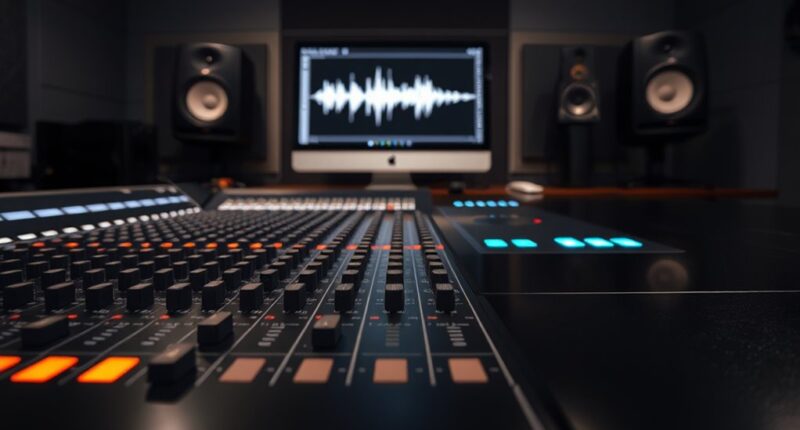Mixing in mono first helps you catch phase issues early, ensuring your elements stay clear and balanced across all playback systems. It simplifies your process by revealing hidden problems like sound cancellation or stereo imbalances that aren’t obvious in stereo view. By starting in mono, you set a strong, cohesive foundation before expanding to stereo, making your mix more professional and reliable. Keep exploring, and you’ll discover how this technique can transform your mixing approach.
Key Takeaways
- Mixing in mono first reveals phase issues early, ensuring elements stay coherent across all playback systems.
- It helps identify and fix frequency masking and overlapping sounds, improving clarity and separation.
- Mono monitoring promotes balanced stereo imaging, preventing hard panning from causing imbalances or phase cancellation.
- Starting in mono simplifies tonal adjustments, leading to a more focused and cohesive mix before stereo widening.
- Pros use mono first to enhance overall translation, ensuring the mix sounds good on any device or environment.
Origins and Evolution of the Mono Mixing Technique
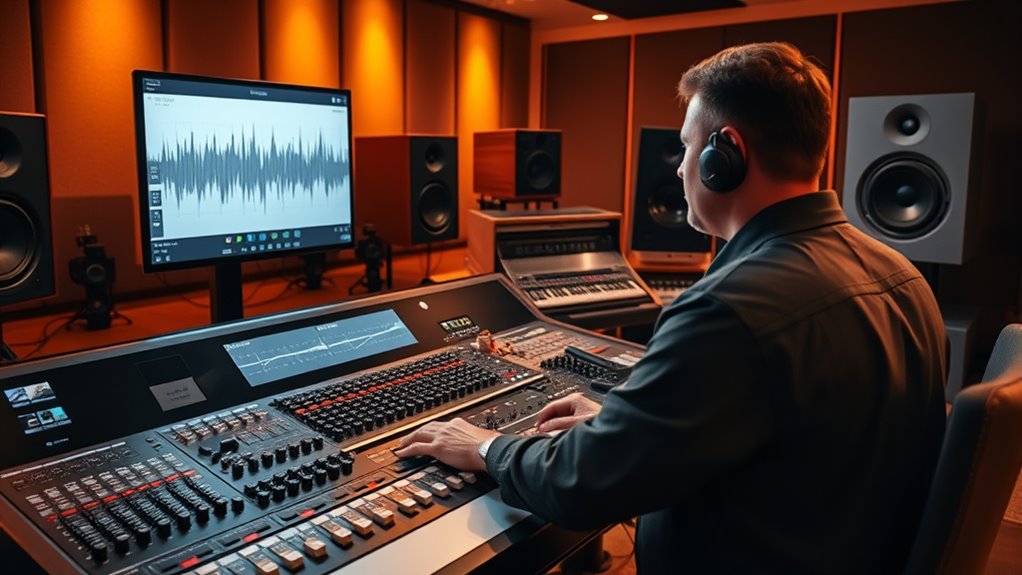
The origins of the mono mixing technique date back to the early days of sound recording when engineers focused on creating a single, unified audio image. Back then, recording technology was limited, and stereo wasn’t available. Engineers had to rely on mono to guarantee clarity and consistency across different playback systems. This approach simplified mixing and made it easier to control sound balance. As recording technology advanced, stereo became more popular, offering a wider soundstage. Despite this, professionals recognized the value of mono for pinpointing issues and ensuring compatibility. Over time, mono evolved from a practical necessity to a tool used consciously in modern mixing. Today, many pros revisit mono early in their process to achieve better clarity, phase coherence, and a solid foundation for stereo and surround mixes. Additionally, understanding sound wave manipulation can help engineers refine their approach to mono and stereo balancing, especially when working with complex phase relationships. Recognizing the importance of color accuracy in audio ensures that sound elements are properly balanced and conveyed, much like how accurate color reproduction enhances visual fidelity in projectors. Incorporating listening techniques can further enhance the engineer’s ability to identify issues and craft a more precise mix.
The Science Behind Mono Mixing and Phase Coherence
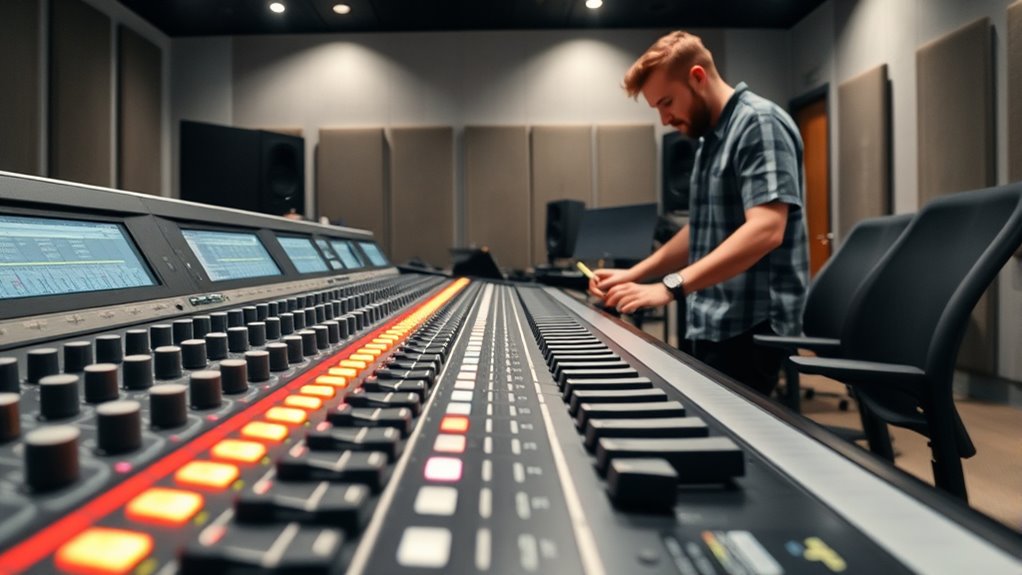
Understanding the science behind mono mixing and phase coherence is essential because it directly impacts how your audio sounds across different systems. When you mix in mono, you’re ensuring all elements combine properly without phase issues that can cause cancellation or imbalance. Phase coherence refers to how sound waves from different sources align; if they’re out of sync, parts of your mix can vanish or sound hollow. Imagine:
- Waves crashing together, perfectly in sync, creating a solid wall of sound.
- Two instruments fighting each other, canceling out certain frequencies.
- A vocal sitting smoothly without phasing issues.
- The difference between a tight, focused mix and a thin, hollow one.
- Achieving proper phase alignment can greatly improve your overall mix clarity and listener experience.
- Proper phase management also helps prevent audio distortion when playing across multiple speakers or headphones.
Common Mixing Pitfalls Addressed by Mono Compatibility
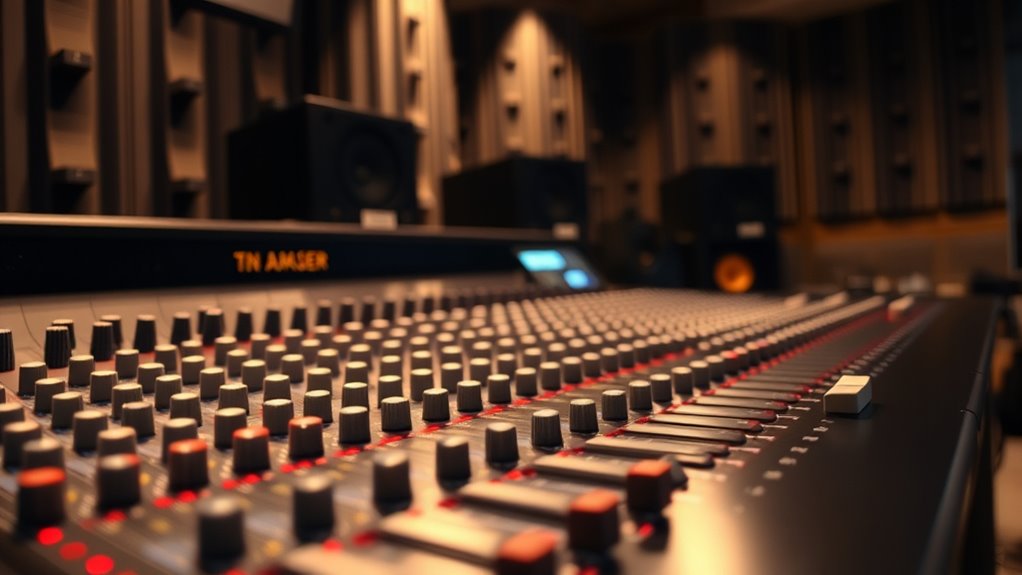
When you check your mix in mono, you’ll spot phase cancellation issues that cause elements to disappear or sound thin. It also highlights stereo image imbalances, making some sounds seem too wide or misplaced. Addressing these problems guarantees your mix remains clear and focused, no matter how it’s played. Incorporating ethical hacking principles like continuous monitoring and vulnerability assessment can help ensure your mix stays resilient against potential issues. Recognizing relationship patterns in your mix can help you understand how different elements interact and influence each other, leading to a more cohesive sound. Additionally, using high-quality comfort solutions such as supportive monitor stands can improve your listening environment and minimize fatigue during mixing sessions. Paying attention to educational toys that promote sensory processing and critical listening can further enhance your ability to identify subtle mix issues and refine your craft.
Phase Cancellation Issues
Phase cancellation issues often sneak into your mix when multiple tracks with similar content aren’t aligned properly, causing frequencies to negate each other out. This can result in a thin, hollow sound or lost clarity. When vocals, guitars, or drums are out of phase, their waveforms can interfere destructively. Imagine:
- Two snare hits, slightly out of sync, dulling the punch
- Overlapping vocals fighting each other, losing presence
- Stereo elements canceling in mono, creating gaps
- Multiple guitar tracks, conflicting and thinning the overall tone
These problems happen when tracks aren’t carefully aligned or checked in mono. By identifying phase issues early, you ensure your mix remains full, punchy, and well-defined across all playback systems. Mono compatibility acts as a safeguard against these common pitfalls and highlights the importance of phase alignment in achieving a professional sound. Additionally, ensuring your tracks are properly tuned to the same key can prevent unintended dissonance that might complicate mono compatibility.
Stereo Image Imbalance
Stereo image imbalance is a common mixing pitfall that can cause your track to feel uneven or disorienting. When certain elements are panned too hard or unevenly, your mix can seem lopsided, distracting the listener and reducing cohesion. This imbalance can make vocals, instruments, or effects feel disconnected or misplaced in the stereo field. It also hampers the sense of width and depth, making your mix less immersive. To fix this, you should regularly check your mix in mono to identify any parts that dominate or disappear when summed. Balancing the stereo spread ensures that no single element overwhelms the others, creating a more centered, stable, and natural sound. Using mono compatibility as a guide helps you craft a more balanced, professional-sounding stereo image.
Clarity and Focus
Balancing the stereo image is key to achieving clarity and focus in your mix. When elements clash or are misplaced, your track loses definition. By checking your mix in mono first, you guarantee each sound occupies its own space without masking others. This reveals issues like overlapping frequencies or muddy sounds that obscure clarity.
Imagine your mix as:
- A clean, crisp vocal sitting clearly above a balanced rhythm section
- Instruments each occupying distinct, non-overlapping spots
- Low-end frequencies that don’t mush together or cause rumble
- High frequencies that sparkle without harshness
Addressing these pitfalls in mono helps you craft a focused, transparent sound. It forces you to make deliberate choices, sharpening the overall clarity and making your mix more compelling across all playback systems.
Step-by-Step Guide to Incorporating Mono in Your Workflow

Start by setting up a dedicated mono track for your mix. Focus on balancing the tonal elements before gradually shifting to stereo. Be careful when widening your stereo image to maintain clarity and cohesion. Remember to consider the overall ambience and how each element interacts within a Bedroom setting to achieve a harmonious soundstage.
Set Up Your Mono Track
To incorporate a mono track into your workflow, begin by creating a new track in your digital audio workstation (DAW) and setting it to mono mode. This simple step focuses your attention on how elements sit together without the distraction of stereo width. Next, choose the instrument or vocal you want to monitor in mono. Adjust its panning to center, ensuring it plays through only one channel. To help visualize the process, imagine:
- Clicking “New Track” in your DAW’s menu
- Selecting “Mono” from the track settings
- Dragging your audio clip onto the new mono track
- Panning the track fully left or right to confirm mono output
This setup primes your ears for critical listening and better decision-making during the mixing process. Understanding the evolving landscape of cryptocurrencies can also enhance your overall approach to digital audio and production workflows, especially when considering digital menu solutions that aim to streamline customer interactions.
Focus on Tonal Balance
After setting up your mono track, focusing on tonal balance helps you identify and correct frequency issues that may be masked in stereo. By listening in mono, you can pinpoint muddy lows, harsh highs, or midrange problems that might otherwise go unnoticed. Adjust EQ to achieve a balanced sound across all frequencies. Use the table below to guide your tonal adjustments:
| Frequency Range | Common Issue | Suggested Fix |
|---|---|---|
| 20Hz – 200Hz | Muddy bass, boominess | Cut or tighten subs |
| 200Hz – 2kHz | Muddiness, boxiness | Reduce problematic mids |
| 2kHz – 8kHz | Harshness, sibilance | Slight attenuation |
| 8kHz – 20kHz | Brightness, hiss | Tame excessive high end |
Focusing here ensures your mix sounds clear and balanced when played in mono or stereo. Additionally, understanding frequency ranges can help you target specific issues during the EQ process. Recognizing how different audio frequency ranges influence the overall sound helps in making precise adjustments for clarity and tonal balance. It’s also helpful to consider the headphone jacks compatibility and settings to ensure your monitoring environment accurately reflects your adjustments.
Transition to Stereo Carefully
Switching from mono to stereo requires careful attention to maintain balance and avoid phase issues. As you expand your mix, listen closely to how elements spread across the stereo field. To do this effectively, consider these steps:
- Gradually pan sounds, starting with subtle movements to prevent abrupt shifts.
- Use high-quality panning tools to position tracks smoothly.
- Regularly check for phase coherence with stereo meters or phase correlation tools.
- Constantly compare your stereo mix back to your mono version to guarantee elements stay solid and centered.
Tools and Equipment That Facilitate Mono Mixing

Using the right tools and equipment can make mono mixing much more manageable and accurate. A dedicated mono switch on your mixer or audio interface is essential; it lets you instantly listen in mono without altering your mix. Studio monitors with mono summing capabilities help you hear how your mix translates to mono, revealing phase issues. A high-quality headphones with mono compatibility allows precise monitoring on the go. Additionally, metering tools like correlation meters help identify phase problems early, ensuring your mix remains clear. Some digital audio workstations (DAWs) include mono summing features or plugins that simplify this process. These tools streamline your workflow, making it easier to identify issues and craft a balanced, phase-coherent mono mix from the start.
Real-World Examples of Mono Mixing Enhancing Clarity
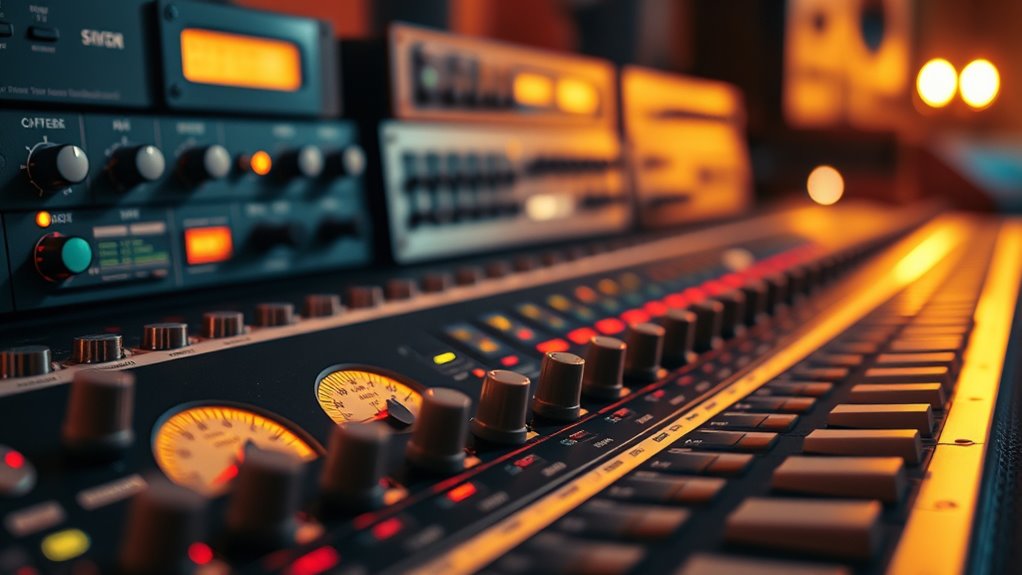
Real-world examples reveal how mono mixing can substantially improve clarity in a mix. Imagine a busy drum track where each element competes for space. When you switch to mono, you notice how the bass becomes punchier, vocals sit clearer, and cymbals sound more focused. This technique forces you to prioritize essential elements, reducing muddiness. For instance, you might see:
Mono mixing sharpens clarity by making bass punchier, vocals clearer, and cymbals more focused.
- Vocals cut through with more presence, making lyrics easier to understand
- Guitar and keyboard parts occupying distinct spaces without clashing
- Percussion elements sounding tighter and more defined
- Overall mix feeling more cohesive and balanced
These adjustments help you identify and fix problematic overlaps, leading to a cleaner, more transparent final product. Mono mixing acts as a clarity filter, revealing issues that can get buried in stereo.
Tips for Transitioning From Stereo to Mono and Back

Have you ever struggled to smoothly switch between stereo and mono during mixing? To make transitions seamless, start by toggling between both modes frequently throughout your session. Use the shortcut keys in your DAW to save time and avoid disruption. Before switching, check your panning and levels in stereo to identify potential issues. When moving to mono, listen for phase cancellations or lost elements, then adjust your mix accordingly. When returning to stereo, double-check your spatial placement and balance. Keep a mental note or a quick reference of your settings so you can revert easily. Practice these exchanges regularly to build confidence. Over time, you’ll develop an intuitive feel for how your mix behaves in both modes, ensuring smooth, efficient workflow.
Frequently Asked Questions
How Does Mono Mixing Influence Overall Song Cohesiveness?
Mixing in mono helps you focus on how well all elements blend together. It strips away stereo effects, revealing any frequency clashes or imbalance. By doing this first, you guarantee your song sounds cohesive on any system, from headphones to big speakers. It encourages you to clarify the core elements, making sure they sit well together before adding stereo width. Ultimately, it creates a more unified, polished sound.
Can Mono Mixing Improve Audio for Streaming Platforms?
Think of mono mixing as tuning a musical engine—when everything’s balanced in mono, your track sounds clear and unified across devices. Yes, mono mixing can improve your audio for streaming platforms, ensuring your mix translates well on all speakers. It helps you identify issues early and creates a more consistent sound. By doing so, your music will shine brighter in streaming environments, reaching more listeners with a polished, professional quality.
What Are Common Mistakes When Shifting Between Mono and Stereo?
When shifting between mono and stereo, you might overlook phase issues or misalignments that cause your mix to sound hollow or phase-cancelled. You may also forget to check how elements like panning or stereo effects translate in mono, leading to imbalance or loss of clarity. Always listen critically in both modes, ensuring your EQ, levels, and effects work well together. This helps you catch problems early and craft a balanced, professional sound.
Is Mono Mixing Suitable for All Music Genres?
Mono mixing isn’t suitable for every music genre, especially those that rely heavily on stereo effects, like electronic or classical music. However, it’s invaluable for genres like rock or pop, where clarity and punch are key. You should consider mono mixing to guarantee your core elements sound solid and balanced. It helps identify phase issues and makes your mix more compatible across different playback systems.
How Do I Train My Ears to Detect Phase Issues in Mono?
To train your ears to detect phase issues in mono, start by listening to your mixes in mono regularly. Focus on how different elements blend and identify any unnatural thickness or hollow sounds. Use phase correlation meters and solo tracks to compare stereo and mono versions. Practice with known phase problems to sharpen your detection skills. Over time, you’ll develop an intuitive sense for spotting phase issues quickly.
Conclusion
Mastering mono mixing makes your music more polished and punchy. By blending balance, boosting clarity, and breaking barriers, you’ll build a better, more balanced sound. Embrace the “mix in mono first” mantra to minimize muddiness, maximize phase coherence, and make your mixes more magnetic. Remember, consistent practice and careful calibration create clearer, cleaner results. So, take the leap, trust the technique, and transform your tunes with confidence and clarity.
